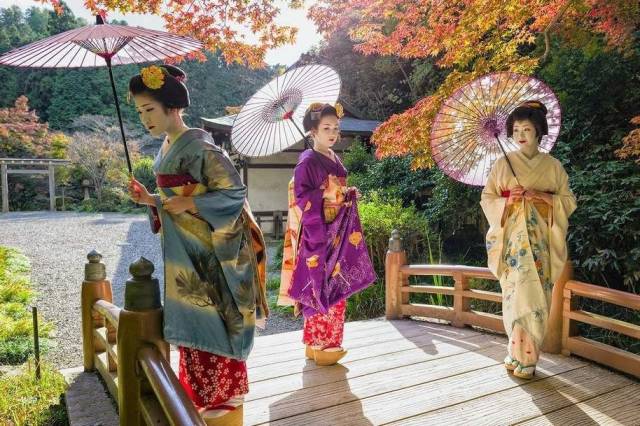Geisha Show

Geisha and Geisha Show
In Tokyo and other Kanto regions, it is called Geisha and in the internship period, it is called Hangyoku. In the Kansai region, such as Kyoto and Osaka, it is called Geiko amd during the internship period it is called Maiko.
In the past, it was usually the rich and powerful men of the upper class who enjoyed the performance of prostitutes, and the men who talked about business in restaurants and tea houses liked to have a geisha accompany them, perform songs and dances for them, pour wine and serve food, and adjust the atmosphere.
Geisha clothing is a very gorgeous kimono, workmanship, texture and decoration are very good, so it is also extremely expensive, some kimono more than 500,000 yen, some even up to 1 million yen. The white dress, the exquisite kimono, and the Shimada style are the most popular appearances of the geisha. Geisha maintain a tactful but reserved demeanor in front of guests, concealing their joys and sorrows behind their thick makeup. Through their natural talents and rigorous training, geisha embody the idealized image of a perfect woman.
The history of Geisha
The geisha system is said to have emerged in the 17th century, and must be a trained performer who pleases guests through talent. In the 1920s, there were as many as 80,000 geisha in Japan, but by the early 2000s the number had dwindled to one to two thousand. The Japanese Geisha originated in the 17th century in Tokyo and Osaka. The original geisha were all men who made a living playing traditional drum music and rapping for fun in brothels and casinos. Around 1750, the first female geisha appeared. In the mid-18th century, the geisha profession was gradually replaced by women, and the tradition continued.

Where to see Geisha, Geisha show and performance in Japan?
The reason why the Japanese geisha dance is very impressive to everyone is that the Japanese geisha dance is not only a dance, but also a dance of art and etiquette, giving people a feeling of elegance. Dancing is also a major part of geisha performances. Their dance originates from traditional Japanese operas such as Kabuki, in which geishas wear colorful kimonos and dance to the sound of drums and strings using silk umbrellas and paper fans as props.
It’s difficult to see geishas in most cities in Japan, except for Kyoto and Tokyo. As the geisha center, Kyoto hosts about 100 geiko and 100 maiko. To meet and talk to a geisha, visitors can attend a geisha tea ceremony or geisha show. Visitors can even join the geisha makeover experience in Kyoto. There are five hanamachi in Kyoto where geiko and maiko live and work. Hanamachi means flower town. These districts have a long history of geiko culture. The best time to visit a hanamachi is between 17:30 and 18:00, as the geiko and maiko usually arrive after 17:45 for events. Each of the five geisha districts in Kyoto also hosts many some public dance shows every year.
Here is a list of Kyoto’s main geisha dances:
Miyako Odori, held daily in April, is the biggest and most spectacular geisha dance in Kyoto. The ticket price is 4000-7000 yen.
Kyo Odori, held daily first to third Sunday in April in Kyoto Art Theater, is the second biggest geisha dance in Kyoto. The ticket price is 5500 yen.
Kitano Odori, held daily between 15 and 25 April in Kamishichiken Kaburenjo Theater, of which the ticket price is 6000 yen.
Kamogawa Odori, held daily between 1 and 24 May in Pontocho Kaburenjo Theatre, is a fine performance put on by the geisha of the Pontocho geisha district.The ticket price is 4000-7000 yen.
Miyako no Nigiwai, held from Jun.24 to Jun.25 in Minamiza Theatre, comprising of over 60 maiko and geiko from Kyoto’s five hanamachi. The ticket price is 6500-14000 yen.
Gion Odori, held daily between 1 and 10 November in Gion Kaikan, is a cute dance in a smaller venue than the above dances.
In the 50-minute show, visitors can enjoy different performances, including Kyo-mai (Kyoto-style traditional dance), tea ceremony, Ikebana (traditional flower-arranging), Koto (a traditional six-string musical instrument), Gagaku (a traditional kind of music and dance performed at shrines, temples, and the Imperial Court), Bunraku (UNESCO list of Masterpieces of the Oral and Intangible Heritage of Humanity), Kyogen (comedy theater depicting aspects of everyday Japanese life).
If you don’t manage to make it to Kyoto to see the geisha of Gion, there’re still opportunities to see geisha in Tokyo. Where to meet geisha and enjoy geisha show in Tokyo?
At the Nihonbashi Information Center, visitors can watch an hour-long performance geishas play shamisen and perform various traditional dances. The show is held on the irst 4 Saturdays of the month and costs 5500 yen.
At Asakusa Tourism and Culture Center, visitors can attend a traditional dance and music show performed by geishas free of charge (only 100 seats).
Tokyo’s six hanamachi - Shinbashi, Yoshicho, Hachioji, Mukojima, Kagurazaka and Asakusa, which are home to restaurants, teahouses and training areas for geisha. Alternatively, you can try your luck and explore the quiet alleys in the hope of spotting a geisha on her way to an appointment.
Recommended tour packages with geisha show in Kyoto:
6 days Kyoto history and culture tour package4 days Kyoto autumn leaves and geisha tour package


